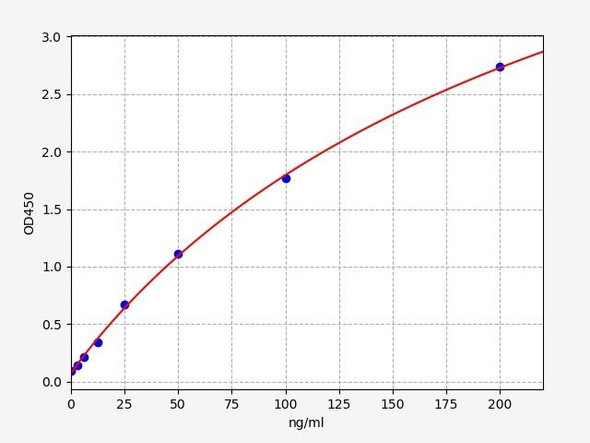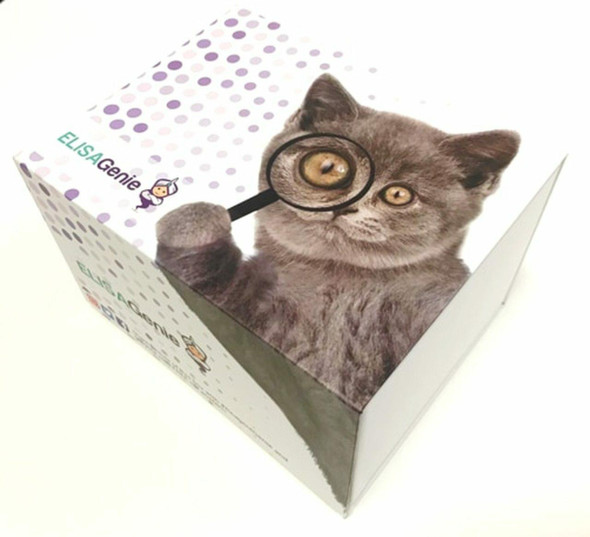Mouse Hepcidin (Hamp) ELISA Kit (MOEB1827)
- SKU:
- MOEB1827
- Product Type:
- ELISA Kit
- Size:
- 96 Assays
- Uniprot:
- Q9EQ21
- Range:
- 6.25-400 pg/mL
- ELISA Type:
- Sandwich
- Synonyms:
- Hepc, Hepcidin, HAMP, HFE2B, LEAP1, PLTR, LEAP-1, hepcidin antimicrobial peptide, Putative liver tumor regressor, Liver-expressed antimicrobial peptide 1
- Reactivity:
- Mouse
Description
Mouse Hepcidin (Hamp) ELISA Kit
The Mouse Hepcidin (HAMP) ELISA Kit from Assay Genie is a high-quality assay designed for the accurate measurement of Hepcidin levels in mouse serum, plasma, and tissue homogenates. This kit offers superior sensitivity and specificity, providing reliable and reproducible results for a variety of research applications.Hepcidin is a key regulator of iron homeostasis, playing a critical role in the control of iron absorption and distribution in the body. Dysregulation of Hepcidin levels has been linked to a variety of disorders, including anemia, hemochromatosis, and inflammation-related conditions.
Therefore, monitoring Hepcidin levels is essential for understanding iron metabolism and its impact on health and disease.The Mouse Hepcidin (HAMP) ELISA Kit is easy to use and requires minimal sample volume, making it ideal for high-throughput studies and experimental research. Trust Assay Genie for accurate and reliable measurements of Hepcidin levels in mouse samples, advancing your research in iron metabolism and related fields.
| Product Name: | Mouse Hepcidin (Hamp) ELISA Kit |
| SKU: | MOEB1827 |
| Size: | 96T |
| Target: | Mouse Hepcidin (Hamp) |
| Synonyms: | Hamp1, Hepc, Hepc1 |
| Assay Type: | Sandwich |
| Detection Method: | ELISA |
| Reactivity: | Mouse |
| Detection Range: | 6.25-400pg/mL |
| Sensitivity: | 3.165pg/mL |
| Intra CV: | 5.8% | ||||||||||||||||||||
| Inter CV: | 11.7% | ||||||||||||||||||||
| Linearity: |
| ||||||||||||||||||||
| Recovery: |
| ||||||||||||||||||||
| Function: | Liver-produced hormone that constitutes the main circulating regulator of iron absorption and distribution across tissues. Acts by promoting endocytosis and degradation of ferroportin, leading to the retention of iron in iron-exporting cells and decreased flow of iron into plasma. Controls the major flows of iron into plasma: absorption of dietary iron in the intestine, recycling of iron by macrophages, which phagocytose old erythrocytes and other cells, and mobilization of stored iron from hepatocytes. |
| Uniprot: | Q9EQ21 |
| Sample Type: | Serum, plasma, tissue homogenates, cell culture supernates and other biological fluids |
| Specificity: | Natural and recombinant mouse Hepcidin |
| Subcellular Location: | Secreted |
| Storage: | Please see kit components below for exact storage details |
| Note: | For research use only |
| UniProt Protein Function: | HAMP: Seems to act as a signaling molecule involved in the maintenance of iron homeostasis. Seems to be required in conjunction with HFE to regulate both intestinal iron absorption and iron storage in macrophages. Defects in HAMP are the cause of hemochromatosis type 2B (HFE2B); also known as juvenile hemochromatosis (JH). HFE2B is a disorder of iron metabolism with excess deposition of iron in the tissues, bronze skin pigmentation, hepatic cirrhosis, arthropathy and diabetes. The most common symptoms of hemochromatosis type 2 at presentation are hypogonadism and cardiomyopathy. Belongs to the hepcidin family. |
| UniProt Protein Details: | Protein type:Secreted; Secreted, signal peptide Chromosomal Location of Human Ortholog: 7 B1|7 19.27 cM Cellular Component: extracellular region; extracellular space; nucleus Molecular Function:copper ion binding; hormone activity Biological Process: cellular iron ion homeostasis; cellular response to extracellular stimulus; defense response to bacterium; defense response to fungus; iron ion homeostasis; JAK-STAT cascade; myeloid cell homeostasis; negative regulation of bone resorption; negative regulation of inflammatory response; negative regulation of transcription from RNA polymerase II promoter; positive regulation of macrophage activation; positive regulation of transcription from RNA polymerase II promoter |
| NCBI Summary: | This gene encodes hepcidin, an antimicrobial peptide and master hormonal regulator of systemic iron metabolism. The encoded preproprotein is synthesized in the hepatocytes where it undergoes proteolytic processing to generate disulfide-linked mature peptides that are secreted into the bloodstream. Mice lacking the encoded protein develop multivisceral iron overlaod, with sparing of the spleen macrophages. Certain mutations in the human ortholog of this gene cause hemochromatosis type 2B, also known as juvenile hemochromatosis. This gene is located adjacent to a related hepcidin gene on chromosome 7. [provided by RefSeq, Aug 2016] |
| UniProt Code: | Q9EQ21 |
| NCBI GenInfo Identifier: | 14211542 |
| NCBI Gene ID: | 84506 |
| NCBI Accession: | NP_115930.1 |
| UniProt Related Accession: | Q9EQ21 |
| Molecular Weight: | |
| NCBI Full Name: | hepcidin preproprotein |
| NCBI Synonym Full Names: | hepcidin antimicrobial peptide |
| NCBI Official Symbol: | Hamp |
| NCBI Official Synonym Symbols: | Hepc; Hamp1; Hepc1 |
| NCBI Protein Information: | hepcidin |
| UniProt Protein Name: | Hepcidin |
| Protein Family: | Heparin-sulfate lyase |
| UniProt Gene Name: | Hamp |
| Component | Quantity (96 Assays) | Storage |
| ELISA Microplate (Dismountable) | 8×12 strips | -20°C |
| Lyophilized Standard | 2 | -20°C |
| Sample Diluent | 20ml | -20°C |
| Assay Diluent A | 10mL | -20°C |
| Assay Diluent B | 10mL | -20°C |
| Detection Reagent A | 120µL | -20°C |
| Detection Reagent B | 120µL | -20°C |
| Wash Buffer | 30mL | 4°C |
| Substrate | 10mL | 4°C |
| Stop Solution | 10mL | 4°C |
| Plate Sealer | 5 | - |
Other materials and equipment required:
- Microplate reader with 450 nm wavelength filter
- Multichannel Pipette, Pipette, microcentrifuge tubes and disposable pipette tips
- Incubator
- Deionized or distilled water
- Absorbent paper
- Buffer resevoir
*Note: The below protocol is a sample protocol. Protocols are specific to each batch/lot. For the correct instructions please follow the protocol included in your kit.
Allow all reagents to reach room temperature (Please do not dissolve the reagents at 37°C directly). All the reagents should be mixed thoroughly by gently swirling before pipetting. Avoid foaming. Keep appropriate numbers of strips for 1 experiment and remove extra strips from microtiter plate. Removed strips should be resealed and stored at -20°C until the kits expiry date. Prepare all reagents, working standards and samples as directed in the previous sections. Please predict the concentration before assaying. If values for these are not within the range of the standard curve, users must determine the optimal sample dilutions for their experiments. We recommend running all samples in duplicate.
| Step | |
| 1. | Add Sample: Add 100µL of Standard, Blank, or Sample per well. The blank well is added with Sample diluent. Solutions are added to the bottom of micro ELISA plate well, avoid inside wall touching and foaming as possible. Mix it gently. Cover the plate with sealer we provided. Incubate for 120 minutes at 37°C. |
| 2. | Remove the liquid from each well, don't wash. Add 100µL of Detection Reagent A working solution to each well. Cover with the Plate sealer. Gently tap the plate to ensure thorough mixing. Incubate for 1 hour at 37°C. Note: if Detection Reagent A appears cloudy warm to room temperature until solution is uniform. |
| 3. | Aspirate each well and wash, repeating the process three times. Wash by filling each well with Wash Buffer (approximately 400µL) (a squirt bottle, multi-channel pipette,manifold dispenser or automated washer are needed). Complete removal of liquid at each step is essential. After the last wash, completely remove remaining Wash Buffer by aspirating or decanting. Invert the plate and pat it against thick clean absorbent paper. |
| 4. | Add 100µL of Detection Reagent B working solution to each well. Cover with the Plate sealer. Incubate for 60 minutes at 37°C. |
| 5. | Repeat the wash process for five times as conducted in step 3. |
| 6. | Add 90µL of Substrate Solution to each well. Cover with a new Plate sealer and incubate for 10-20 minutes at 37°C. Protect the plate from light. The reaction time can be shortened or extended according to the actual color change, but this should not exceed more than 30 minutes. When apparent gradient appears in standard wells, user should terminatethe reaction. |
| 7. | Add 50µL of Stop Solution to each well. If color change does not appear uniform, gently tap the plate to ensure thorough mixing. |
| 8. | Determine the optical density (OD value) of each well at once, using a micro-plate reader set to 450 nm. User should open the micro-plate reader in advance, preheat the instrument, and set the testing parameters. |
| 9. | After experiment, store all reagents according to the specified storage temperature respectively until their expiry. |
When carrying out an ELISA assay it is important to prepare your samples in order to achieve the best possible results. Below we have a list of procedures for the preparation of samples for different sample types.
| Sample Type | Protocol |
| Serum | If using serum separator tubes, allow samples to clot for 30 minutes at room temperature. Centrifuge for 10 minutes at 1,000x g. Collect the serum fraction and assay promptly or aliquot and store the samples at -80°C. Avoid multiple freeze-thaw cycles. If serum separator tubes are not being used, allow samples to clot overnight at 2-8°C. Centrifuge for 10 minutes at 1,000x g. Remove serum and assay promptly or aliquot and store the samples at -80°C. Avoid multiple freeze-thaw cycles. |
| Plasma | Collect plasma using EDTA or heparin as an anticoagulant. Centrifuge samples at 4°C for 15 mins at 1000 × g within 30 mins of collection. Collect the plasma fraction and assay promptly or aliquot and store the samples at -80°C. Avoid multiple freeze-thaw cycles. Note: Over haemolysed samples are not suitable for use with this kit. |
| Urine & Cerebrospinal Fluid | Collect the urine (mid-stream) in a sterile container, centrifuge for 20 mins at 2000-3000 rpm. Remove supernatant and assay immediately. If any precipitation is detected, repeat the centrifugation step. A similar protocol can be used for cerebrospinal fluid. |
| Cell culture supernatant | Collect the cell culture media by pipette, followed by centrifugation at 4°C for 20 mins at 1500 rpm. Collect the clear supernatant and assay immediately. |
| Cell lysates | Solubilize cells in lysis buffer and allow to sit on ice for 30 minutes. Centrifuge tubes at 14,000 x g for 5 minutes to remove insoluble material. Aliquot the supernatant into a new tube and discard the remaining whole cell extract. Quantify total protein concentration using a total protein assay. Assay immediately or aliquot and store at ≤ -20 °C. |
| Tissue homogenates | The preparation of tissue homogenates will vary depending upon tissue type. Rinse tissue with 1X PBS to remove excess blood & homogenize in 20ml of 1X PBS (including protease inhibitors) and store overnight at ≤ -20°C. Two freeze-thaw cycles are required to break the cell membranes. To further disrupt the cell membranes you can sonicate the samples. Centrifuge homogenates for 5 mins at 5000xg. Remove the supernatant and assay immediately or aliquot and store at -20°C or -80°C. |
| Tissue lysates | Rinse tissue with PBS, cut into 1-2 mm pieces, and homogenize with a tissue homogenizer in PBS. Add an equal volume of RIPA buffer containing protease inhibitors and lyse tissues at room temperature for 30 minutes with gentle agitation. Centrifuge to remove debris. Quantify total protein concentration using a total protein assay. Assay immediately or aliquot and store at ≤ -20 °C. |
| Breast Milk | Collect milk samples and centrifuge at 10,000 x g for 60 min at 4°C. Aliquot the supernatant and assay. For long term use, store samples at -80°C. Minimize freeze/thaw cycles. |








